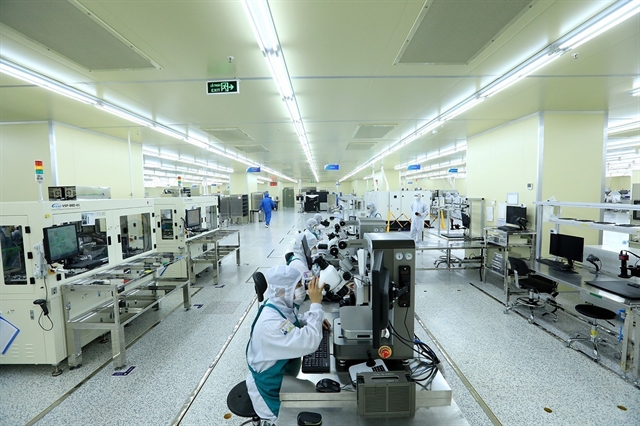 |
| A semiconductor production line of Hana Micro Vina Co, Ltd in Vân Trung Industrial Zone in Việt Yên District, Bắc Giang Province. — VNA/VNS Photo Tuấn Anh |
Minister of Planning and Investment Nguyễn Chí Dũng emphasised that by 2045, Việt Nam will emerge as a pivotal link in the global semiconductor industry value chain, with a competent workforce of engineers and experts capable of meeting the demands for both quality and quantity in the development of the semiconductor industry.
He made the statement at a working session on Wednesday to gather feedback on the draft plan on developing human resources for the semiconductor industry until 2030, with a vision to 2045, as assigned by the Government in Resolution 124 issued on August 7, 2023.
At the working session, Dũng acknowledged the contributions of relevant authorities participating in drafting the plan, as well as their active co-operation with the ministry and relevant agencies in developing the ecosystem and workforce for the semiconductor industry.
The ministry will focus on collecting feedback from relevant authorities to finalise the plan and submit it to the Government in the first quarter of 2024. This will accelerate progress toward the goal of enabling Vietnamese engineers to deeply engage in the design process of modern semiconductor chips by 2030.
Specifically, by 2030, Việt Nam will be deeply involved in the packaging and testing stages of semiconductor chips, mastering a portion of the packaging and testing technology. Vietnamese engineers will work in semiconductor manufacturing plants, gradually mastering technology in the production process and training 50,000 engineers to serve the industry in all stages of the value chain.
Vũ Quốc Huy, director of the National Innovation Centre (NIC) and representative of the drafting committee, provided an overview of the research and development of the draft plan, and proposed some content for feedback to refine the draft plan in the upcoming time.
Representatives from agencies, enterprises, universities and research institutes highly appreciated the necessity and content of the draft plan on developing the domestic semiconductor industry.
The delegates generally agreed with the ministry’s proposals and contributed many opinions in developing the workforce for the semiconductor industry, especially the roles of major technology enterprises, State-owned enterprises, State investment resources, business-university linkages, international cooperation in training, importing training programmes and attracting talents.
![]()
Illustrative image (internet)
The delegates also stressed the role of the ministry as the leading and coordinating agency in implementing the draft plan, as well as the role of the NIC in deploying activities to develop the ecosystem and workforce for Việt Nam's semiconductor industry through collaborations with organisations, enterprises and universities from countries with strong semiconductor sectors such as the United States, Japan, Germany, South Korea and the Netherlands.
Prior to this, from September 2023 to February 2024, the ministry assigned the NIC to organise various activities to serve the development of the draft plan such as surveying semiconductor chip companies to assess the demand for workforce of companies operating in Việt Nam; surveying leading research institutes and universities in Việt Nam to assess training and research capabilities in the semiconductor industry.
Additionally, the NIC sought opinions from experts regarding Việt Nam's demand forecast and training capacity until 2030, with a vision towards 2045, with the participation of leading experts working in the United States, Taiwan (China), France, the Netherlands, Japan, South Korea and Belgium.
It also conducted surveys and consultations with consulting organisations, associations, universities and major corporations worldwide in the semiconductor industry regarding development trends, recruitment needs, experience in implementing training programs and workforce development in the industry.
It organised discussions to evaluate the needs of potential investing semiconductor companies, international training institutions, cooperation, and scholarship provision for Việt Nam. It also collaborated with Vietnamese experts in Silicon Valley, the United States, and leading semiconductor industry enterprises and universities such as Cadence, FPT and Arizona State University to organise short-term training programmes for lecturers, students and engineers in related fields who wish to transition to the semiconductor industry.
VNS





